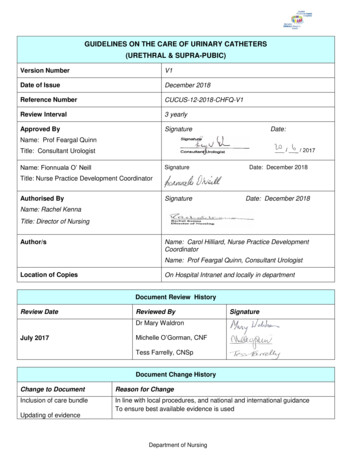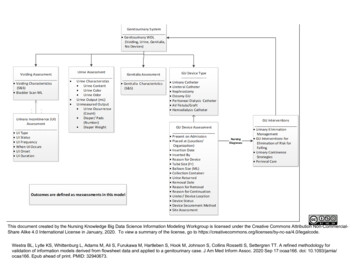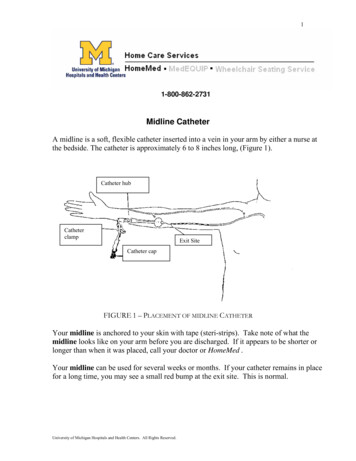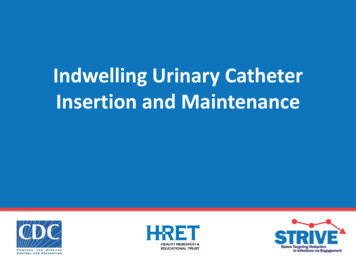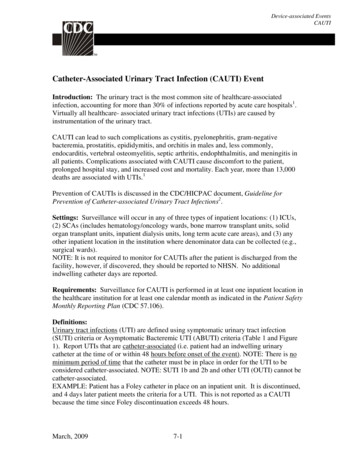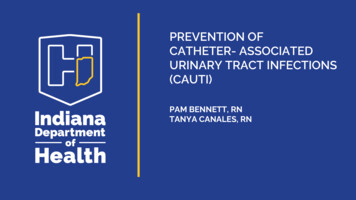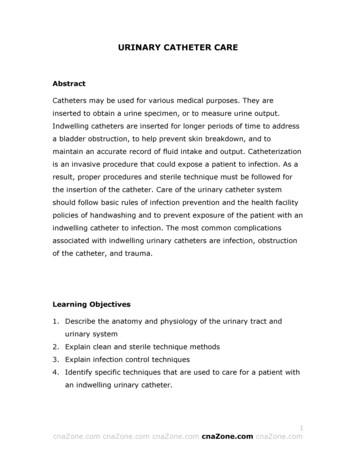
Transcription
URINARY CATHETER CAREAbstractCatheters may be used for various medical purposes. They areinserted to obtain a urine specimen, or to measure urine output.Indwelling catheters are inserted for longer periods of time to addressa bladder obstruction, to help prevent skin breakdown, and tomaintain an accurate record of fluid intake and output. Catheterizationis an invasive procedure that could expose a patient to infection. As aresult, proper procedures and sterile technique must be followed forthe insertion of the catheter. Care of the urinary catheter systemshould follow basic rules of infection prevention and the health facilitypolicies of handwashing and to prevent exposure of the patient with anindwelling catheter to infection. The most common complicationsassociated with indwelling urinary catheters are infection, obstructionof the catheter, and trauma.Learning Objectives1. Describe the anatomy and physiology of the urinary tract andurinary system2. Explain clean and sterile technique methods3. Explain infection control techniques4. Identify specific techniques that are used to care for a patient withan indwelling urinary catheter.1cnaZone.com cnaZone.com cnaZone.com cnaZone.com cnaZone.com
IntroductionProper urinary catheter care is an important skill that all certifiednursing assistants (CNAs) should be able to perform. There aredifferent types of catheters. This module will discuss care of patientswith indwelling catheters. Competence at providing urinary cathetercare requires a CNA to understand and apply the following: 1) Basicinformation about the anatomy and physiology of the urinary tract andurinary system; 2) the sterile technique, 3) infection controltechniques; and, 4) specific techniques that are used to care for apatient who has a urinary catheter.Indwelling CathetersThe word catheter is a medical term that refers to a tube that can beinserted into a body cavity, a body duct, or a blood vessel. There areseveral types of catheters that can used to drain urine from thebladder: indwelling catheters, sheath catheters (also known as condomor Texas catheters), and straight catheters that are inserted to obtaina urine specimen and then removed.Indwelling catheters are inserted into the bladder and left in place. Acatheter can remain in the bladder for a period of time that dependson the purpose for the procedure and other factors. Some indwellingurinary catheters (suprapubic catheters) are inserted into the bladderthrough a small incision that is made in the abdominal wall but mostare inserted into the bladder through the urethra. A catheter insertedthrough the urethra is the focus of this section. These catheters arecommonly referred to as Foley catheters, or a Foley. Foley is the nameof the physician who first designed this type of urinary catheter, whichis in common use today.2cnaZone.com cnaZone.com cnaZone.com cnaZone.com cnaZone.com
Some patients who do not have voluntary control of urinary functionand need a urinary catheter may be managed using intermittentcatheterization. This procedure is often called a straightcatheterization. Straight catheterization is also performed when asterile urine specimen needs to be obtained.Anatomy and Physiology of the Urinary SystemThe urinary system forms urine, and the urinary tract stores,transports, and excretes urine. The urinary tract and the urinarysystem are comprised of these organs and structures: Kidneys:There are two kidneys. They are located on the right and leftsides of the abdominal cavity, and they are approximately at thelevel of the navel. The kidneys perform several importantfunctions but their primary role is the production of urine. Ureters:The ureters are short, narrow tubes that originate at the bottomof the kidneys. Each kidney is supplied with one ureter and thefunction of the ureters is to carry urine from each kidney to thebladder. Bladder:The bladder is a thin-walled, hollow organ that is similar in shapeand size to a small balloon. It is located in the abdominal cavityabove the pubic area and below the navel. The function of thebladder is to collect and store the urine that is produced by thekidneys. The bladder can stretch quite a bit, and it can store3cnaZone.com cnaZone.com cnaZone.com cnaZone.com cnaZone.com
approximately 700-800 mL of urine. This is approximately 23-26ounces. The bladder walls have three layers of smooth muscle.The importance of these muscles is discussed below. Urethra:The urethra is a small diameter tube that begins at the bottomof thebladder. The purpose of the urethra is to carry the urinefrom the bladder to external environment. The end of theurethra is called the urethral meatus. In women the urethralmeatus is located above the opening of the vagina. In men theurethra travels through the penis and the urethral meatus islocated at the tip of the penis.The Urinary System4cnaZone.com cnaZone.com cnaZone.com cnaZone.com cnaZone.com
The primary functions of the urinary system are to form, store,transport, and excrete urine, and the formation and excretion of urineis one of the ways that the body maintains a healthy internalenvironment. Excess acids and other waste products that are producedby metabolism are excreted in the urine. Blood urea nitrogen (BUN)and creatinine are waste products that are made when our bodiesprocess proteins and by the normal metabolism of the muscles. Bloodurea nitrogen and creatinine are filtered out of the blood by thekidneys and eliminated by the urine. Blood urea nitrogen andcreatinine are produced in large amounts, and they can be toxic if theirlevels in the blood get too high. Blood levels of BUN and creatinine arecommon laboratory tests that are used to evaluate how well thekidneys and the urinary system are functioning.Depending on whether the body needs more or less fluid to functionproperly, the kidneys will produce and eliminate more or less urine.This process can also be manipulated by giving drugs such as diureticsthat increase the amount of urine that is produced. This is helpful forpeople who have medical conditions such as congestive heart failureand/or hypertension.Proper functioning of the urinary system is critical. If the kidneyscannot filter out waste products and conserve water or get rid ofexcess water, and if the urinary tract cannot transport the urine andeliminate it, it is impossible for the brain, the circulation, the heart,and other vital organs to function properly.Urine formation is done by filtering blood that passes through thekidneys. The kidneys have a large blood supply and while a person is5cnaZone.com cnaZone.com cnaZone.com cnaZone.com cnaZone.com
at rest the kidneys receive approximately 25% of all the blood that ispumped by the heart. As the blood passes through the circulation ofthe kidneys, water and metabolic waste products are filtered out fromthe blood and pass into collecting tubules in the kidneys; these wasteproducts and the water are, essentially, the urine. The urine movesthrough the collecting tubules in the kidneys, from the kidneys theurine passes through the ureters and into the bladder, and from thebladder the urine passes through the urethra and is eliminated.Urination is the process of emptying the bladder and eliminating theurine. Although the bladder can store 700-800 mL of urine, it rarelyholds that much. Most people feel the urge to urinate when thebladder contains 200-400 mL of urine. When the level of urine in thebladder reaches that amount, the bladder walls are stretched and thisstretch sends a nerve impulse to the brain. The brain in turn sends outa message that stimulates the smooth muscles of the bladder wall anda message to muscles that surround the urethra near the urethralmeatus. The bladder walls contract, the muscles around the urethrarelax, and urine is passed. This process is referred to as the micturitionreflex.Bladder wall stretch Nerve impulse to brain Smooth muscles contract Urethra relaxes Urine is passedThe urinary system is comprised of the kidneys, the ureters, thebladder and the urethra. The primary function of the urinary system is6cnaZone.com cnaZone.com cnaZone.com cnaZone.com cnaZone.com
to produce urine and the production and elimination of urine is one ofthe ways the body eliminates harmful wastes and conserves oreliminates water. Urine formation occurs in the kidneys, and urinationis the process of elimination of urine.The Indwelling Urinary Catheter SystemThe indwelling urinary catheter system is comprised of the catheter,the collecting tubing, and the collecting bag. Indwelling urinarycatheters are long, narrow tubes made of latex or silicone. The size ofurinary catheters is measured using the French system, typicallyabbreviated as “Fr”. Most indwelling urinary catheters are size 14, 16or 18 French, but larger or smaller ones can be used.Urinary catheters have two passages called lumens. One lumen is fordraining urine and the other is for inflating the balloon that keeps thecatheter in place. One end of the catheter tube - the end that insertedinto the bladder - has several small openings into the lumen thatdrains urine, and below these openings is a small, inflatable balloon.This end of the catheter is inserted into the urethra and advanced untilit passes into the bladder.When the catheter is in the bladder and urine begins to flow out, theballoon is inflated and the catheter is gently pulled back until theballoon rests on the bladder wall; this keeps the catheter in thebladder. The openings that are below the balloon drain the urine fromthe bladder. The other end of the catheter has a large opening that isconnected to a collecting tube that is attached to the collecting bag.The collecting bag has a valve at its bottom, which can be opened andclosed in order to periodically empty the bag.7cnaZone.com cnaZone.com cnaZone.com cnaZone.com cnaZone.com
Purpose of Indwelling CatheterThere are many reasons why an indwelling urinary catheter would beplaced. However, the three most common reasons for insertion of anindwelling urinary catheter are: 1) Bladder outlet when there isobstruction, 2) Prevention of skin breakdown, and 3) Maintaining anaccurate record of fluid intake and output.An indwelling urinary catheter may also be placed if the patient is inintensive care or for some of the following reasons.Obstruction:Urinary tract obstructions are relatively common. Obstructions canhappen at any point along the urinary tract. A patient who has achronic obstruction may be able to expel some urine but not empty thebladder completely. A patient may have difficulty starting or stoppingthe stream, or need to urinate many times during the day. Commoncauses of urinary obstruction include: 1) swelling of the prostate gland(in men), 2) medication side effects, 3) an infection causing damage tothe urinary tract, 4) a kidney stone, 5) reaction to anesthesia usedduring surgery, 6) a tumor somewhere in the urinary tract, and7) damage to the nervous system, such as a stroke. Obstructions maybe acute or chronic.Potential for Skin Breakdown:Patients who have lost bladder control cannot voluntarily determinewhen they will urinate. The inability to control urinary function is calledincontinence.8cnaZone.com cnaZone.com cnaZone.com cnaZone.com cnaZone.com
Having urine in constant contact with the skin is unpleasant, but theconsequences of urinary incontinence are far more serious thandiscomfort. If a patient is incontinent of urine and the skin hasprolonged contact with urine, skin breakdown, rashes, pressure ulcers,and other dermatologic problems can occur. Some of these canseriously impact a patient’s health. Patients who have chronic urinaryincontinence that is caused by a medical condition that cannot becorrected, for example, paralysis from a stroke or an accident, or anobstruction that cannot be medically or surgically corrected may needa permanent indwelling urinary catheter to prevent skin breakdown.Chemical Paralysis or Sedation:Some patients need to be chemically paralyzed or heavily sedated; forexample, patients who are mechanically ventilated need to be sedatedfor management issues. In these situations, an indwelling urinarycatheter is appropriate.Fluid Monitoring:In certain clinical situations monitoring a patient’s intake and outputcan be critically important. Examples of these situations would includepatients with severe, extensive burns, or patients with serious cardiacproblems such as a myocardial infarction or pulmonary edema.Surgical Considerations:There many reasons why a patient who is having surgery may need anindwelling urinary catheter. Some patients may be in the operatingroom for a long time, or they may be undergoing a urologic procedure.The patient may need large amounts of fluids or diuretics during the9cnaZone.com cnaZone.com cnaZone.com cnaZone.com cnaZone.com
procedure. There may be a need for precise recording of intake andoutput.Diagnostic or Therapeutic Procedures:An indwelling urinary catheter may be inserted to deliver medication tothe urinary system. One may also be inserted so that radiopaque dyescan be given as part of a diagnostic test.Significant Pelvic Injury:In a situation of significant injury to the pelvis, hospice care and theneed for comfort would be implemented. Often patients with atraumatic pelvic injury will have continuous urinary catheters in placethat require ongoing monitoring.There are many good reasons for inserting an indwelling urinarycatheter but the decision to place an indwelling catheter should beconsidered seriously, and they should never be placed if there is areasonable alternative or simply as a convenience for the nursing staff.Urinary Catheter InsertionIn some U.S. states and in some facilities the Certified NursingAssistant (CNA) is allowed, after the proper education and supervision,to perform intermittent catheterization and insertion of an indwellingurinary catheter. The two procedures will be briefly reviewed here butthe primary focus of this section is about providing care to a patientwho has a urinary catheter already in place.10cnaZone.com cnaZone.com cnaZone.com cnaZone.com cnaZone.com
Reading and understanding the information provided here aboutintermittent catheterization and insertion of an indwelling urinarycatheter should not be considered sufficient preparation for performingthese procedures. However, a basic understanding is useful for anyonewho is caring for a patient who has a catheter in place or who needsintermittent catheterization. The basics of the procedure are simple,but doing it quickly and efficiently does require some coordination,planning, and practice.Catheterization is an invasive procedure, and it is uncomfortable andpossibly embarrassing for the patient. In order to complete theprocedure correctly and safely, the following points need to befollowed. Make sure to have explained the procedure to the patient beforestarting the procedure; this would include the purpose ofcatheterization - why it is needed and what is going to be done.The patient’s privacy should be maintained at all times. Plenty of time should be allowed, and rushing should be avoided. It is normal for the patient to feel pressure, discomfort, and a milddegree of pain or irritation when the catheter is being inserted.Before starting the procedure, this should be explained ot thepatient. It is also normal to need to apply a slight degree of pressure tomove the catheter through the urethra; force should never beused. If a patient is having significant pain or the technician finds that alot of pressure is needed to advance the catheter, the procedure11cnaZone.com cnaZone.com cnaZone.com cnaZone.com cnaZone.com
should be stopped and the CNA should inform a nursing orphysician supervisor of the situation. Continuing in thosecircumstances can easily cause trauma to the urethra.Intermittent CatheterizationIntermittent catheterization is typically used for people who have aneurogenic bladder. A neurogenic bladder is a bladder that hasstopped functioning normally. The most common cause of aneurogenic bladder is a stroke. The stroke causes damage to the partof the brain that controls the muscles and nerves of the bladder andthe process of urination cannot longer be voluntarily controlled.Intermittent catheterization has many advantages for people who havea neurogenic bladder. It can be performed by a family member or bythe person who needs it. It avoids the risks and complications ofhaving an indwelling catheter and it helps preserve normal kidneyfunction. Intermittent catheterization also gives the person who has aneurogenic bladder a greater sense of independence.The procedure of intermittent catheterization can be done in two ways:clean or sterile. Insertion of a urinary catheter has traditionally beenconsidered to be a procedure that required sterile technique. However,at this time there is no evidence that sterile technique is superior toclean technique for performing intermittent catheterization.Sterile technique is still the mandatory technique for inserting anindwelling urinary catheter. This is because indwelling catheter willtypically be in place for several days, which may compromise the12cnaZone.com cnaZone.com cnaZone.com cnaZone.com cnaZone.com
patient’s defenses against infection, and create a possible entry pointfor microorganisms.Clean Technique:1. Wash the hands.2. Lubricate the catheter with water-soluble lubricant. Some urinarycatheterization kits are supplied with a lubricating gel that containsa local anesthetic, and this can help the patient tolerate theprocedure.3. Wash the area around the meatus with soap and water. Start atthe center and move outward, using a circular motion.4. For men, position the patient on the back and move the penis sothat the tip is pointed towards the patient’s head. For women,position the patient on her back and have her legs supported in acomfortable position.5. Gently insert the catheter and keep advancing it until urine beginsto flow.6. When the desired amount of urine has been drained or the urinestops flowing, slowly remove the catheter.7. If there is resistance when the catheter is being inserted - this iswhen the catheter is inserted but it does not easily move forward do not use force. Simply apply a gentle, steady pressure and inmost cases the catheter will advance.Sterile Technique:1. Wash the hands.2. Lubricate the catheter with a water-soluble lubricant.3. Put on sterile gloves.13cnaZone.com cnaZone.com cnaZone.com cnaZone.com cnaZone.com
4. Use a sterile wipe to clean the meatus and the area around themeatus.5. Follow Steps 4-6 from the description of clean technique.Indwelling Catheter InsertionIndwelling catheter insertion is done using sterile technique. Theprocedure is done in the same way as intermittent catheterization. Theonly differences are that the urinary catheter is connected to adrainage bag, and after the catheter has entered the bladder and urinebegins to flow, the catheter balloon is inflated.Urinary catheters are supplied in various sizes. The choice of whichFrench size to use is guided by patient comfort and the physicianorder. If performing an intermittent catheterization, a small Frenchsize would be used to avoid pain and trauma. In most cases a 12French for women and a 14 French for men is the largest size thatshould be used for intermittent catheterization, and smaller is alwaysbetter. An indwelling catheter should usually, but not always, be alittle larger in size. The physician who ordered the placement of theindwelling urinary catheter may order a specific size to be used. If not,someone can contact the physician and ask for guidance. The CNAshould ask a supervisor which size should be used if this has not beenspecified.Basics of Urinary Catheter CareIf a patient has an indwelling urinary catheter, the CNA must know:1) Why the patient has an indwelling catheter, 2) Concepts of steriletechnique and prevention of infection, 3) The complications associatedwith an indwelling urinary catheter, and 4) Specific techniques that are14cnaZone.com cnaZone.com cnaZone.com cnaZone.com cnaZone.com
used to care for the patient who has a urinary catheter. Thesetechniques may differ depending on where the CNA works but they allhave the same goal, which is the prevention of complications andinfections.Maintaining Sterility and Infection PreventionSterile technique refers to specific methods that are used to preventinfection when caring for a patient. The term sterile means completelyfree of microorganisms such as bacteria and viruses. Sterile techniqueis used in many types of patient care scenarios, but the most commonis when the clinical situation or the patient’s condition creates apotential entry point into the body for microorganisms. For example,when a patient is undergoing a surgical procedure, the surgeon andthe operating room staff will use sterile technique; everything thatdoes or could come in contact with the patient during the surgeryshould not only be clean, but must be sterile because the integrity ofthe skin is disrupted and the skin is one of the most important barriersagainst infection.In a patient who has an indwelling urinary catheter, the urethra is theentry point for bacteria and viruses. The indwelling catheter enlargesthe urethral opening and urination (which normally flushes outmicroorganisms that are in the urethra) has been disrupted. Whencaring for a patient who has an indwelling urinary catheter, strictsterile technique is seldom needed, but the CNA must remember thatthe indwelling catheter is a break in the normal body defenses andcertain parts of the system must be considered sterile.Most aspects of indwelling catheter care do not require steriletechnique. However, good infection control practices must always be15cnaZone.com cnaZone.com cnaZone.com cnaZone.com cnaZone.com
followed. This is true when providing care in general for any patient,and the health facility policies for infection control will need to befollowed. The presence of the urinary catheter makes patientsvulnerable to infection and many of them, because of their advancedage or their medical condition, have a compromised immune system.It is part of the CNA’s job to protect them. This section will not providea detailed discussion of infection control and standard precautions, butthe CNA should keep in mind the following points when providingindwelling urinary catheter care for patients. Everyone has microorganisms on their skin; they come into contactwith microorganisms all the time, and the microorganisms thatcause infection can move from one person to another. Contact transmission is the most important way thatmicroorganisms are spread from person to person in the healthcaresetting. Handwashing has been recognized by the Centers for DiseaseControl and Prevention (CDC) as the most important way toprevent the spread of infection. Handwashing should be done as follows: 1) before starting patientcare, the hands should first be washed, 2) when the hands arevisibly soiled, 3) after contact with a patient, 4) after contact withany body secretions, 5) before and after putting on gloves, and6) before and after using the bathroom. Wear gloves when providing urinary catheter care.16cnaZone.com cnaZone.com cnaZone.com cnaZone.com cnaZone.com
Handwashing and barrier protection (wearing gloves) prevent contacttransmission of microorganisms from the healthcare worker, or fromanother patient the healthcare worker has been caring for, to thepatient who has an indwelling urinary catheter.Indwelling Urinary Catheters ComplicationsThe most common complications associated with indwelling urinarycatheters are: 1) Infection, 2) Obstruction of the catheter, and3) Trauma. These will be discussed separately but one can often bethe cause of another.Urinary Tract InfectionsAn indwelling urinary catheter disrupts one of the patient’s normaldefenses against infection, and bacterial growth in the urine iscommon in these patients. After 30 days almost every patient who hasan indwelling urinary catheter will have a significant amount ofbacteria in the urine. Signs of a urinary tract infection tract includefever, bloody urine, and cloudy, foul-smelling urine. The patient mayalso complain of pain or irritation in or around the urethra.Catheter-associated urinary tract infections are a common problem.They are the most common hospital-acquired infection, and they causesignificant harm to the patients and add a large financial burden to thehealthcare system. Fortunately, catheter-associated urinary tractinfections can be prevented, and this can be done by paying strictattention to the following details: 1) Proper insertion of the catheter,2) Proper care of the catheter, and 3) Proper removal of the catheter.17cnaZone.com cnaZone.com cnaZone.com cnaZone.com cnaZone.com
The first step in preventing a catheter-associated urinary tractinfection is to question the need for the catheter and avoid placing oneif possible. Studies have shown that between 21-55% of patients whohad an indwelling urinary catheter did not need them since there wasno appropriate indication for placement of a catheter. Carefulevaluation of the patient’s need for an indwelling catheter cansignificantly reduce the number of catheterizations and the number ofcatheter-associated infections.If insertion of an indwelling urinary catheter is necessary, the followingsteps will help prevent infection. Strict attention to proper technique will help reduce the risk ofinfection. Use good handwashing technique before starting theinsertion, and use personal protective equipment (PPE) if indicated. Make sure that the drainage system is always closed. Always keep the drainage tubing in the proper position so thaturine flow is not obstructed. Keep the drainage bag below the level of the bladder. Remove the catheter as soon as possible. Removing an indwellingurinary catheter as soon as possible, preferably within 24-48 hourof insertion, greatly decreases the risk of developing an infection.Obstruction of the CatheterObstruction of urinary catheters is relatively common, as well. Signsand symptoms of catheter obstruction of a blockage include a decreasein urine output and flow, pain, and leakage of urine around theurethral meatus.18cnaZone.com cnaZone.com cnaZone.com cnaZone.com cnaZone.com
Obstruction can happen if there is are mechanical problems with thedrainage system, but these can be easily identified and easilyprevented with proper positioning of the tubing and the bag.Obstructions are also caused by dehydration. If the patient’s fluidintake is less than optimal and dehydration results, the urine becomesconcentrated and less diluted than it usually would be. When thishappens, sediment that is normally present in the urine also becomesconcentrated, the sediment can form a plug, and the catheter becomesobstructed.A urinary tract infection and/or the presence of microorganisms in theurine or in the drainage lumen of the catheter can also cause anobstruction. The microorganisms that grow in the urine and in thedrainage lumen secrete a sticky film that protects them fromantibiotics and from the body’s immune system. Over time, this stickyfilm can grow, form plugs in the drainage lumen, and cause andobstruction.TraumaThe word trauma usually implies something dramatic like a brokenbone or a laceration but trauma can happen at levels that cannot beeasily felt or seen, and that is the case with trauma associated with anindwelling urinary catheter. The trauma that affects an indwellingurinary catheter happens when tension or traction is inadvertentlyapplied to the catheter or the drainage tubing. These mechanicalforces pull the catheter back and forth in the urethra and can damagethe tract.19cnaZone.com cnaZone.com cnaZone.com cnaZone.com cnaZone.com
Signs of trauma include bleeding from the urethral meatus, pain orirritation, and leakage of urine. Trauma increases the risk ofdeveloping a urinary tract infection, so careful attention must be paidto ensure that the catheter and the drainage tubing are correctlypositioned.Caring for the Patient with an Indwelling Urinary CatheterThe following techniques and responsibilities are the basics of care fora patient with an indwelling urinary catheter.Cleaning the Catheter Insertion SiteCleaning of the catheter insertion site should be done at least once aday. The CNA should check the guidelines of the healthcare facility forspecific instructions on how often to do this and for the specific waythe procedure should be done. The basics of the procedure willgenerally include: 1) Wash the hands before starting, 2) Wear gloves,and 3) Clean the area using soap and water. The CNA should makesure - especially for female patients - that cleaning near the urethralopening is done from the front towards the back to avoidcontaminating the catheter insertion site with bacteria from the rectalarea.Soap and water alone is sufficient for cleaning. Antibacterial soaps,solutions, or ointments do not provide any advantage, nor doantibacterial ointments applied to the area after the cleaning.Maintain the Sterility of the Indwelling Catheter System20cnaZone.com cnaZone.com cnaZone.com cnaZone.com cnaZone.com
The outside of the indwelling catheter system should be clean, but it isnot considered sterile. The inside of the catheter, the inside of thedrainage bag, and the connection between the catheter and thedrainage bag are considered areas that must be kept sterile. The bestway to maintain the sterility of the urinary system is to keep thesystem closed. The CNA should not disconnect the catheter from thedrainage bag tube unless it is necessary to do so.If the catheter is disconnected from the collecting tubing, the CNAshould not touch the tip of the catheter or the collecting tubing. Glovesshould be first applied and the CNA should reconnect the catheter andthe tubing and imm
catheter can remain in the bladder for a period of time that depends on the purpose for the procedure and other factors. Some indwelling urinary catheters (suprapubic catheters) are inserted into the bladder through a small incision that is made in the abdominal wall but most are inserted into the bladder through the urethra. A catheter inserted

